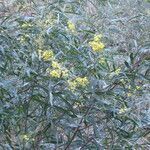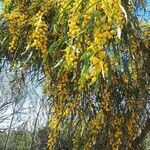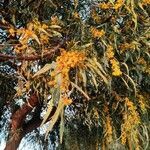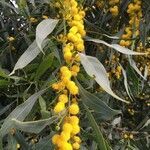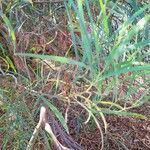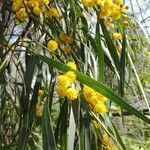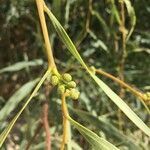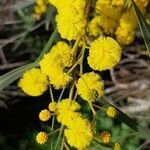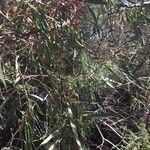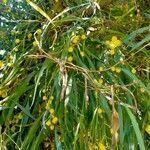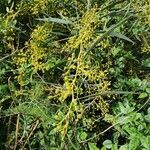Unarmed shrub or tree up to 10 m high; young branchlets slightly angular, glabrous. Leaves phyllodic, apparently simple, glabrous, mostly 8-22 x 0.5-1.4 cm (the lower ones sometimes much longer and 4 cm or more wide), usually narrow, linear-lanceolate to linear-oblong or oblanceolate, straight or slightly falcate, much narrowed basally, with a single main longitudinal nerve and finely but distinctly penninerved, sometimes glaucous, with a basal gland (on young plants and coppice shoots bipinnate leaves are sometimes produced at the apex of the phyllode). Inflorescences globose, 6.5-9 mm in diameter, in short axillary racemes. Flowers bright yellow; peduncles 0.6-2.2 cm long. Calyx slightly pubescent apically. Corolla glabrous. Pods brown, 5.5-15 x 0.5-0.6 cm, straight or slightly falcate, flattened, margins slightly constricted between some of the seeds, dehiscing longitudinally. Seeds dark brown, 5-7 x 2.75-3.5 mm, smooth, compressed; caruncle conspicuous; areole 3.5-5 x ±1.5 mm.
It is a dense bushy evergreen shrub. It grows 3-10 m tall and spreads to 3-6 m across. The stem is erect but the branches have a graceful weeping habit. They hang downwards. The bark is smooth and red brown. The leaves (phyllodes) are thin and taper towards the tip. They vary a lot in size and shape. They are 8-25 cm long by 1-8 cm wide. They can be curved. They are soft greyish green. The leaves have prominent veins. Five flower heads are carried on a flower stalk. These flowers tend to be towards the ends of branches. The flower heads are balls and are deep yellow or golden. They are 0.5-1 cm across. They heads or balls are made up of 25-75 small flowers. The pods are pea like. They are 5-15 cm long and 0.5-0.6 cm across. The pods are flat and contracted between the seeds. They can be slightly curved and are smooth and brown. The seeds are lined along the pod. The seeds are edible
Small tree or shrub, 3-10 m high, stems deformed by large galls. Branches slightly angular when young, glabrous. Leaves phyllodia, apparently simple, blue-green to bright green, glabrous, linear-lanceolate to linear-oblong, straight or slightly falcate, narrowed at base, 80-220 x 5-14 mm, lower leaves may be larger, single prominent midvein, young plants or coppice shoots may have bipinnate lamina at apex of phyllodia. Flowers globular heads in short axillary racemes, bright yellow. Flowering time Nov. Pod brown, 55-150 x 5-6 mm, straight or slightly falcate, flattened, margins whitish, hard, dehiscent.
Resprouting shrub or tree, 3-7(-10) m tall, often with large, brown galls formed by a rust fungus. Phyllodes oblong-lanceolate, with a single midvein, much wider and wavy on young plants, pinnate leaves only in seedlings. Flowers in axillary globose heads, bright yellow. Pod compressed, constricted between seeds, with hardened whitish margins.
Resprouting shrub to 6 m. Phyllodes oblong-lanceolate, with 1 central, longitudinal vein, blue green turning bright green. Flowers in globose heads, bright yellow. Pods flat, constricted between seeds.
